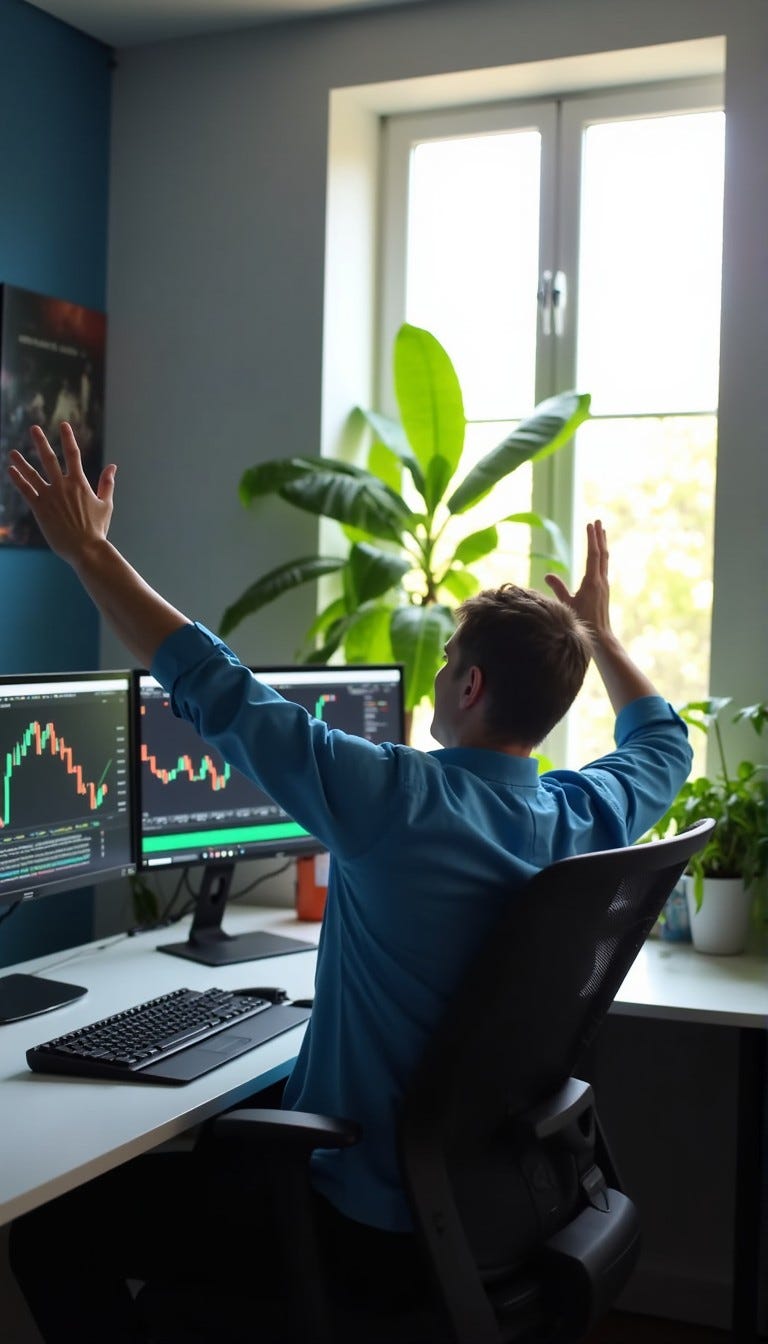Do you ever feel like the world of trading moves too fast to keep up—especially if you’re juggling work, family, or other priorities? You’re not alone.
Big institutions and seasoned pros seem to have an edge, with entire teams dedicated to crunching market data and monitoring price trends.
But here’s the thing: thanks to breakthroughs in artificial intelligence (AI) and powerful copy trading platforms, everyday investors now have access to sophisticated strategies once reserved for the elite.
In this article, we’re going to explore how AI-powered copy trading offers a fresh alternative to the age-old guesswork of “buy low, sell high.” We’ll dig into why algorithmic trading can outpace human intuition and how you can harness pre-built systems that mirror successful trades—saving you time and effort in the process.
Whether you’re new to the market or you’ve tried (and struggled) on your own, this guide will give you a clear roadmap for getting started.
Let’s peel back the curtain on AI-driven trading systems, highlight the potential benefits, and be real about the risks—because, let’s face it, no investment is a guaranteed win.
By the end, you’ll have actionable steps to join this emerging wave of automated strategies and level the playing field against big-time traders.
Section 1 – The Problem:
Why Traditional Trading Feels Overwhelming
1.1. The Knowledge Barrier
Maybe you’ve read countless articles, subscribed to finance channels, and tried to keep up with day-to-day news, but it all still feels messy. Financial markets move at breakneck speed, and there’s a flood of technical terms—P/E ratios, moving averages, fundamental analysis, you name it. Even if you learn these concepts, it’s tough to decode the signals in real-time without constant monitoring.
Most of us juggle busy lives. We’re not in a position to watch the stock or crypto ticker all day. Missing just one critical update could mean a missed opportunity or worse—a steep loss. For many would-be investors, the complexity alone is enough to scare them off.
1.2. Emotional Whiplash
Then there’s the emotional roller coaster. Traditional trading can play havoc with your nerves: markets plunge, news headlines exaggerate doom and gloom, and suddenly you’re paralyzed by fear—selling low when you should maybe be hanging on. Or, you see a sudden market upswing and get carried away by greed—buying high, just as prices peak.
This is where AI has the upper hand. Algorithms don’t have emotions. They make decisions purely on data and logic, so the guesswork and adrenaline-driven panic can be eliminated—or at least greatly reduced.
1.3. Limited Time and Resources
Big investment firms have entire departments of analysts poring over decades of historical data, scanning social media sentiment, and placing rapid-fire trades at lightning speed. Meanwhile, you might be looking at the markets on your lunch break or after you tuck the kids into bed.
The mismatch is huge. That’s why many folks either settle for slow-and-steady index funds or just avoid the market altogether—fearing they simply can’t compete. But what if you could effectively “borrow” a proven system or strategy that’s already been tested? That’s the draw of AI-driven copy trading.
Section 2 – The Solution:
Unlocking the Power of AI Copy Trading
2.1. How AI Systems Do What Humans Can’t
AI-powered trading systems analyze massive amounts of data in real-time, scanning for patterns in price action, volume surges, sentiment data, and even correlation to broader news cycles. Where a human can only track a handful of data points at once, an AI can sift through tens of thousands—spotting subtle cues and forming logical, rule-based decisions in a fraction of a second.
Imagine never having to second-guess a chart formation or wonder if you’re reading the signals properly. Instead, you’d rely on a strategy that’s grounded in facts and tested on real-world data. That’s the promise of AI-driven copy trading: not daydreaming about what might happen, but using proven algorithms to guide your moves.
2.2. A Glimpse into Pattern Recognition
Certain AI systems revolve around pattern detection. For example, there’s a formation called the “1-2-3 bottom” that often hints at a market turning point. AI can be configured to spot this pattern across dozens—or even hundreds—of different stocks or cryptos simultaneously. This “go wide and small” approach means you invest just a bit in each identified opportunity, which spreads out your risk rather than betting big on a single pick.
This tactic can be game-changing: you might catch several winning trades without devoting your entire bankroll to just one risky bet. It also breaks you free from the time-consuming job of scanning charts all evening. The AI does the heavy lifting.
2.3. Copy Trading Platforms: Bridging the Gap
So, how do you actually tap into these AI strategies if you’re not a coder or a finance geek? That’s where copy trading platforms come in. They essentially act as a marketplace, showcasing AI-driven strategies (and sometimes human traders too). You can browse performance stats, risk profiles, historical returns, and even read reviews from other users.
Platforms like Bitget, Blofin, or eToro, or other specialized copy trading services allow you to link your account and automatically mirror the trades executed by these AI systems.
It’s a bit like hitting “follow” on a successful influencer, except that influencer is an algorithm that might be running 24/7, scanning every dip and spike in real time.
Section 3 – The Outcome:
Stronger Potential Gains with Smarter Risk
3.1. The “Go Wide and Small” Advantage
One major plus of AI-based copy trading is its ability to diversify rapidly. By spotting a host of potential setups—rather than a single “hot” opportunity—it helps you dodge the all-too-common pitfall of going all-in on one volatile asset. A few trades might fail or hit your stop-loss, but one or two big winners can offset those losses. Over time, small, steady gains can accumulate into something significant.
3.2. Built-In Risk Management
Platforms typically allow you to set specific parameters such as stop-loss orders or daily drawdown limits. The AI or chosen system might even come with these rules pre-coded. Instead of letting your emotions run the show, risk management tools act as a disciplined safety net. If the market dips and hits a set threshold, your capital automatically exits the trade, preserving your funds to fight another day.
This approach is often described as an “insurance policy.” You pay a small amount—your defined potential loss—on each trade for a chance at a far larger return if the trade soars. It’s a more predictable approach than reacting emotionally after you’ve already lost a large chunk of your portfolio.
3.3. Real-World Examples and Success Stories
AI Identifying Undervalued Cryptos
An AI trading system might spot a capitulation point in a smaller cryptocurrency. After a series of algorithmic signals confirm a potential bottom, the system invests a tiny percentage in that coin. If it rallies 5x or 10x, your small initial investment blossoms into a healthy profit—without risking your entire account.Consistent Returns
Some copy trading services focus on currency pairs. Over time, these systems track interest rate changes, economic announcements, and volume patterns. The result is a series of short, precise trades that—while not always huge winners individually—add up over the month.
S1.Capital – Only 29 losing trades vs. 2,120 profitable trades!
HappyPlanets - Win Rate: 99.57% (58,795 profitable trades vs. 254 losing trades)
These stories aren’t to say it’s always smooth sailing. Losses happen. But the structure of algorithmic copy trading helps you manage the worst-case scenarios while keeping you open to the upside.
Conclusion & Call to Action:
Five Steps to Get Started
By now, you might be wondering exactly how to take your first steps. Here’s a five-step roadmap to help you dive into AI-powered copy trading with a balance of excitement and caution:
Research Your Platforms
Look for established copy trading services—especially those offering AI-driven or algorithmic strategies. Check fees, user reviews, and whether they’re legally compliant in your area.Evaluate Trader (or System) Performance
Don’t just chase the biggest headline return. Look for consistency, moderate drawdowns, and a clear risk-management philosophy. Read about the strategy: is it high-frequency, swing trading, or pattern-based? Make sure it aligns with your comfort level.Start with a Demo or Minimal Funds
If a demo account is available, use it to see how trades are copied, how stop-losses are triggered, and get a feel for the platform’s interface—risk-free. No demo? Then start with a tiny deposit you can afford to lose.Monitor & Adjust
Copy trading isn’t a “set it and forget it” solution. Regularly review performance, the system’s open trades, and any changes in market conditions. If you see big red flags—like sudden, uncharacteristic risk—don’t hesitate to pull back or switch to another strategy.Keep Learning & Diversify
As you grow comfortable, you might blend different AI strategies—some focusing on stocks, others on crypto or forex. The key is to avoid locking all your capital into one approach. Meanwhile, keep educating yourself on market concepts and how AI systems interpret data.
Why It Matters
AI-driven copy trading isn’t a guaranteed ticket to millionaire status. But it does offer a structured, technology-backed alternative that may help you avoid some of the emotional pitfalls of old-school, do-it-yourself trading. In a financial landscape often dominated by huge firms, these automated strategies can level the playing field for everyday people—if you go in with your eyes open and a clear plan.
So, ask yourself:
Could AI-powered copying reshape your approach to investing?
Does it give you a path to consistent, data-driven trades while you focus on your regular life? If you’re intrigued, start small. Explore the platforms, read about various algorithms, and follow the step-by-step process above.
It might just be the edge you need in an ever-changing market.
Ready to explore AI-driven copy trading for yourself?
Take that first step: choose a reputable platform like Bitget or Blofin, browse the available AI strategies, and begin with a small deposit or a demo.
Then watch, learn, and tweak as you go. With a balanced mindset and the right strategy, you could open the door to a whole new way of investing—one that harnesses the power of AI to reduce guesswork and give you more confidence in every trade.














Share this post